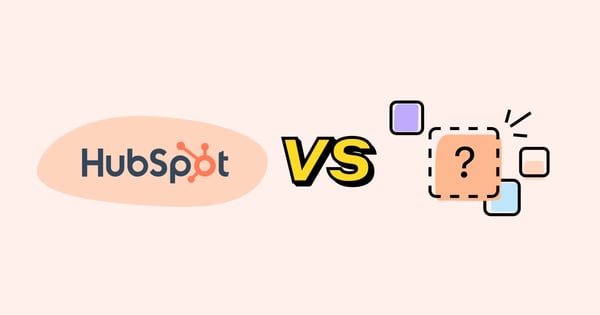Partsales hub, part marketing automation platform, and part CRM software, HubSpot is a decidedly heavyweight tool. Few platforms can go toe-to-toe with it on features.
But HubSpot’s greatest strength—its giddying array of functionality—is also (kind of) its biggest weakness.
Because if you want to access one or two vital tools, you’ll likely find yourself shelling out for a bunch of other stuff you simply don’t need.
Which brings us to HubSpot’s other major drawback: the price tag.
While its entry-level plans (and even its free product tier) are pretty generous, things get real expensive, real fast if you need to bolt-on things like omnichannel automation and dynamic personalization.
And when we say “expensive”, we mean you won’t see much change from $1,000 per month.
Once they’ve weighed up the costs, a lot of brands start shopping around for HubSpot alternatives.
Fortunately, there’s no shortage of options that offer all the features most email marketers require (but at a fraction of HubSpot’s prices). To help you find the right HubSpot alternative for your business, we’ve rounded up 10 of the best and compared them on:
- Price
- Product features
- Customer support
- Pros and cons
- Target audience
Let’s get into it…
What Are the Best HubSpot Alternatives?
| HubSpot Alternatives | Best For | Top Features | Pricing/Month |
| Drip | DTC ecommerce | Segment your whole audience based on real-time store, visitor, and marketing data. | From $39 per month for up to 2,500 contacts and unlimited email sends. |
| Klaviyo | Ecommerce agencies and developers | Personalization and segmentation tools allow you to create customer segments based on real-time data. | Free for up to 250 contacts and 500 monthly email sends; paid plans priced from $20 per month for up to 500 contacts and 5,000 monthly email sends. |
| Mailchimp | Small businesses | Advanced analytics and reporting help marketers make data-driven decisions. | Free for up to 500 contacts and 1,000 monthly email sends; paid plans start at $13 per month for 500 contacts and 5,000 monthly email sends. |
| GetResponse | Small businesses that need advanced marketing tools | Built-in GPT-3.5 powered email generator. | Free for up to 500 contacts and 2,500 monthly email sends. Paid plans start at $13.30 per month for 1,000 contacts and unlimited email sends. |
| Brevo (FKA Sendinblue) | Low-budget email marketing | Send transactional emails with guaranteed 97 percent deliverability. | Free for unlimited contacts and up to 300 emails per day. Paid plans start at $25 per month for unlimited contacts and 20,000 emails per month. |
| Omnisend | Ecommerce marketers | Web push notifications allow brands to instantly retarget customers. | Free to reach up to 250 contacts per month, including 500 monthly email sends, up to 60 SMS messages, and up to 500 web push notifications. Paid plans start at $16 per month to reach up to 500 contacts (including unlimited push notifications). |
| ActiveCampaign | Advanced marketers who need high-level automation | Predictive actions use machine learning to deliver customer experiences based on data, such as the best time to send emails. | From $29 per month for one user and unlimited emails. |
| AWeber | Startups and small businesses | Create email templates in seconds using your website or Facebook page URL. | Free for up to 500 email subscribers and 3,000 monthly email sends; paid plans priced from $16.15 per month for up to 2,500 subscribers. |
| Constant Contact | Nonprofits and charities | Manage campaigns on the go from a dedicated mobile app. | From $12 per month for up to 500 contacts and 5,000 monthly email sends. |
| ConvertKit | Content creators | Integrated newsletter referral program helps creators grow their reach by leveraging their existing audience. | Free for up to 1,000 subscribers and unlimited email sends; paid plans start at $9 per month for up to 300 subscribers and unlimited sends. |

The 10 Best HubSpot Alternatives:
1. Drip
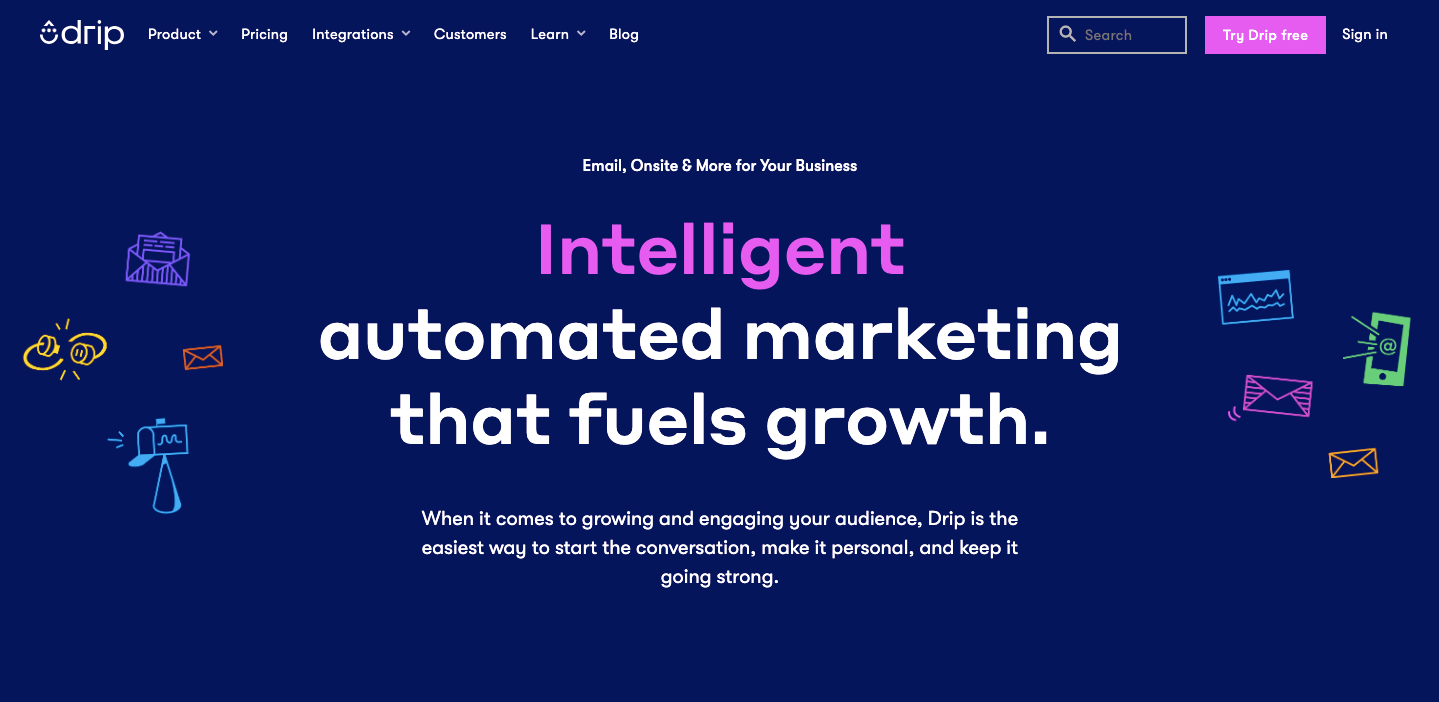 First up is our tool, Drip. We’re a marketing automation platform built for brands selling physical products, services, and experiences. We certainly don’t claim to do all the same stuff as HubSpot, but if you’re looking for an affordable tool packed with features to help you generate sales and revenue, we’re hard to beat.
First up is our tool, Drip. We’re a marketing automation platform built for brands selling physical products, services, and experiences. We certainly don’t claim to do all the same stuff as HubSpot, but if you’re looking for an affordable tool packed with features to help you generate sales and revenue, we’re hard to beat.
What Makes Drip the Best HubSpot Alternative?
- Built for B2C selling. HubSpot is primarily aimed at B2B brands looking to generate leads and sales through inbound marketing. Drip, on the other hand, is all about B2C selling. Whether your website sells clothing, online courses, or physical experiences, our pre-built segments and workflows help you engage your audience and convert them into paying customers.
- Developed with B2C selling in mind. HubSot promises “solutions for every business”. Practically speaking, that means the vast majority of HubSpot customers end up paying for features that weren’t even built for brands in their niche. By contrast, every tool in our platform was designed to help brands selling products, services, and experiences.
- Intuitive user interface. HubSpot has a steep learning curve, particularly if you’re new to the world of marketing automation. Meanwhile, Drip’s intuitive interface and visual editors make it a cinch to get started; we’re a true do it yourself platform.
- Advanced marketing functionality for all. At Drip, we believe every customer should be able to access the same powerful marketing tools. We don’t stop lower-paying customers accessing any of our premium segmentation or automation features away behind a paywall, whereas HubSpot only offers omnichannel automation at Marketing Hub Professional level and above (priced from $800/month).
- Build any automation you want. Use our easy-to-use visual automation builder to craft highly specific automations tailored to your brand and sales funnel. For instance, you can trigger abandoned cart email campaigns when users add an item to their cart, rather than waiting until they’ve dropped out of the checkout process. HubSpot’s automations are harder to customize (and far more expensive).
- Get more for less. We don’t bill ourselves as a “cheap” marketing automation platform, but the fact remains: we let you send more emails and run more onsite campaigns for less money. For instance, we’ll give you unlimited email sends and up to 3,000 contacts for $49/month, whereas HubSpot charges $60/month (plus you only get 15,000 emails a month). And that’s before you factor in the juicy automation and segmentation features we offer as standard on all plans.
How Does Drip Compare to HubSpot?
| Drip | HubSpot | |
| Best Feature | Segment your whole audience based on real-time store, visitor, and marketing data. | Connect marketing, sales, content management, and customer service in a single platform. |
| Best For | DTC ecommerce | B2B inbound marketing |
| Pros | All customers get access to advanced automations and segmentation (however much you pay). | Attractive free plan; excellent free CRM; tons of additional features and tools for sales, customer service, and content management. |
| Cons | No free plan (although we do have a 14-day free trial). | Charges big money for advanced automation and segmentation features. |
| Pricing/Month | From $39 per month for up to 2,500 contacts and unlimited email sends. | Free marketing plan includes unlimited contacts and 2,000 monthly email sends. Paid marketing plans start at $18 per month for 1,000 contacts and 5,000 monthly sends. |
| Support | Our support is rated 8.8 on G2 (vs. an average of 8.6 for marketing automation platforms) and includes live audio screen sharing to solve problems in real time. | Paying customers can get 1:1 email and in-app chat support. Phone support is available at Pro level and above. |
2. Klaviyo
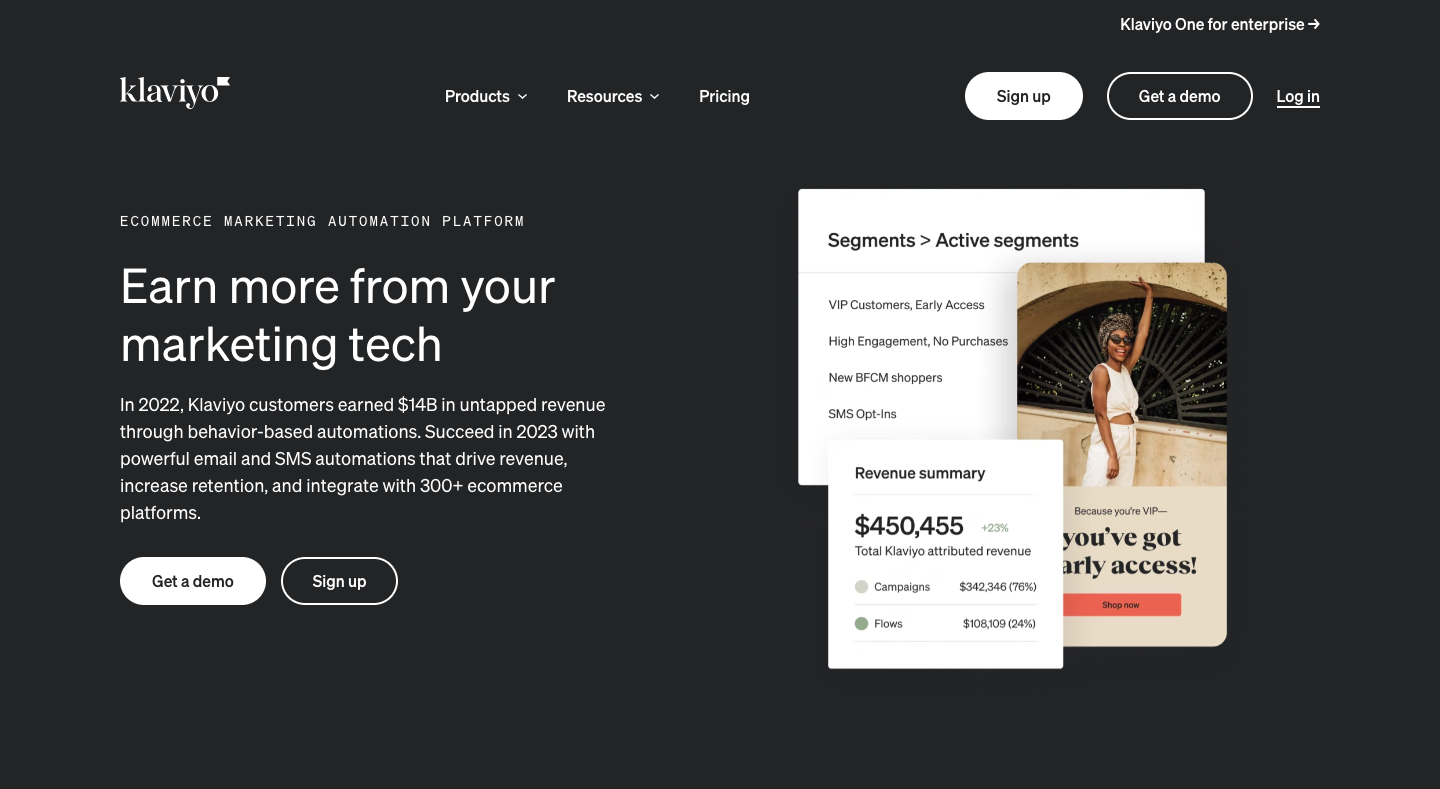 Like Drip, Klaviyo is a marketing automation platform built for brands that sell stuff. It’s not exactly the same as Drip, though, because you’ll need a full-service Klaviyo agency or an in-house dev team to make full use of its features. That makes it prohibitively expensive for a lot of brands—but if you’re seriously considering HubSpot as an option, price probably isn’t an issue!
Like Drip, Klaviyo is a marketing automation platform built for brands that sell stuff. It’s not exactly the same as Drip, though, because you’ll need a full-service Klaviyo agency or an in-house dev team to make full use of its features. That makes it prohibitively expensive for a lot of brands—but if you’re seriously considering HubSpot as an option, price probably isn’t an issue!
What Makes Klaviyo the Best HubSpot Alternative?
- Run (affordable) SMS campaigns. SMS marketing is a key element of Klaviyo’s feature set: from $60/month, you can send up to 1,250 SMS messages per month (plus you get all the platform’s email and automation tools). HubSpot only offers SMS marketing as a beta—and it’s exclusively available at Marketing Hub Professional level and above, so it’ll set you back at least $800/month.
- Predict what customers will do next. Both HubSpot and Klaviyo offer predictive analytics, which uses data science to forecast when an individual customer will place their next order, churn, and more. Again, the difference is in the price: Klaviyo includes predictive analytics with all paid plans, whereas HubSpot only offers it to Enterprise-level customers paying at least $3,600 per month.
- Target customers through push notifications. All Klaviyo users—even those on the free product tier—can run mobile push notification campaigns, giving them another way to reach and engage their audience. Surprisingly, HubSpot doesn’t offer push notifications with any of its plans, although it integrates with various third-party push notification platforms.
- Universal A/B testing. Even though A/B testing is a vital feature for successful email marketing, you’ll need to pay HubSpot at least $800/month to access it. On the flip side, every Klaviyo plan (again, even the free one) comes with A/B testing, allowing you to split-test CTAs, body content, send times, subject lines, and more.
How Does Klaviyo Compare to HubSpot?
| Klaviyo | HubSpot | |
| Best Feature | Personalization and segmentation tools allow you to create customer segments based on real-time data. | Connect marketing, sales, content management, and customer service in a single platform. |
| Best For | Ecommerce agencies and developers | B2B inbound marketing |
| Pros | All plans provide advanced functionality like A/B testing and predictive analytics. | Better free plan; offers built-in tools for sales, customer service, and content management. |
| Cons | HubSpot’s free plan is way more generous. | Need-to-have features like A/B testing are only available at Marketing Professional level and above (costing $800+ per month). |
| Pricing/Month | Free for up to 250 contacts and 500 monthly email sends; paid plans priced from $20 per month for up to 500 contacts and 5,000 monthly email sends. | Free marketing plan includes unlimited contacts and 2,000 monthly email sends. Paid marketing plans start at $18 per month for 1,000 contacts and 5,000 monthly sends. |
| Support | After the extensive onboarding program, support is limited to live chat and emails. | Paying customers can get 1:1 email and in-app chat support. Phone support is available at Pro level and above. |
3. Mailchimp
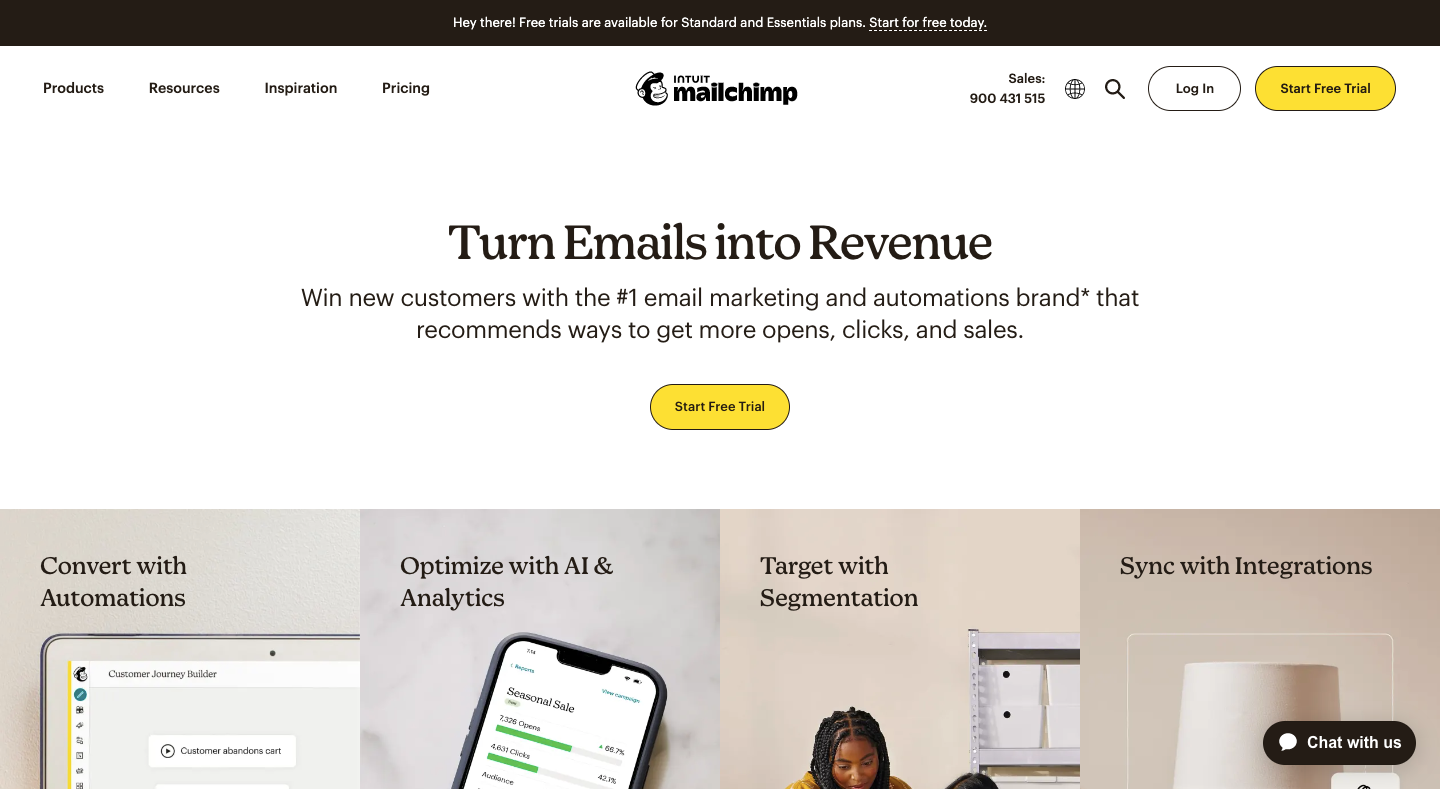 Mailchimp is one of the few marketing tools to boast HubSpot levels of brand awareness. With its all-round feature set, reasonable pricing, and intuitive interface, Mailchimp is the email and automation platform of choice for millions of businesses.
Mailchimp is one of the few marketing tools to boast HubSpot levels of brand awareness. With its all-round feature set, reasonable pricing, and intuitive interface, Mailchimp is the email and automation platform of choice for millions of businesses.
What Makes Mailchimp the Best HubSpot Alternative?
- Advanced reporting tools (at reasonable prices). Mailchimp’s full suite of reporting and analytics tools are unlocked at Standard level, priced from $20/month. By contrast, HubSpot makes you pay for its reporting add-on—at an eye-watering $200/month—to create multiple dashboards and build custom reports.
- Low-cost A/B and multivariate testing. Of course, HubSpot offers A/B testing—pretty much every email platform does. But by limiting it to customers at Professional level and up, it essentially charges $800/month for the privilege. With Mailchimp, you get A/B testing from $13/month and multivariate testing from $20/month.
- Free social posting. Yet again, this isn’t about what Mailchimp does better than HubSpot; it’s about useful tools that HubSpot forces you to pay hundreds of dollars per month to access. All Mailchimp customers—even those on the free tier—can do social posting within the platform, while social scheduling is available at Standard level and above ($20+ per month). You can connect up to 50 social media accounts to HubSpot, but only if you’re prepared to shell out for Marketing Hub Professional (starting at $800/month).
How Does Mailchimp Compare to HubSpot?
| Mailchimp | HubSpot | |
| Best Feature | Advanced analytics and reporting help marketers make data-driven decisions. | Connect marketing, sales, content management, and customer service in a single platform. |
| Best For | Small businesses | B2B inbound marketing |
| Pros | Charges (much) less than HubSpot for vital tools like multivariate testing. | More generous free tools, including a free CRM system. |
| Cons | Less-generous free plan; HubSpot’s CRM is better. | Far too expensive once you outgrow the free plan. |
| Pricing/Month | Free for up to 500 contacts and 1,000 monthly email sends; paid plans start at $13 per month for 500 contacts and 5,000 monthly email sends. | Free marketing plan includes unlimited contacts and 2,000 monthly email sends. Paid marketing plans start at $18 per month for 1,000 contacts and 5,000 monthly sends. |
| Support | Paid plans include 24/7 support via chat and email. Phone and priority support is only available to Premium customers paying $350+ per month. | Paying customers can get 1:1 email and in-app chat support. Phone support is available at Pro level and above. |
4. GetResponse
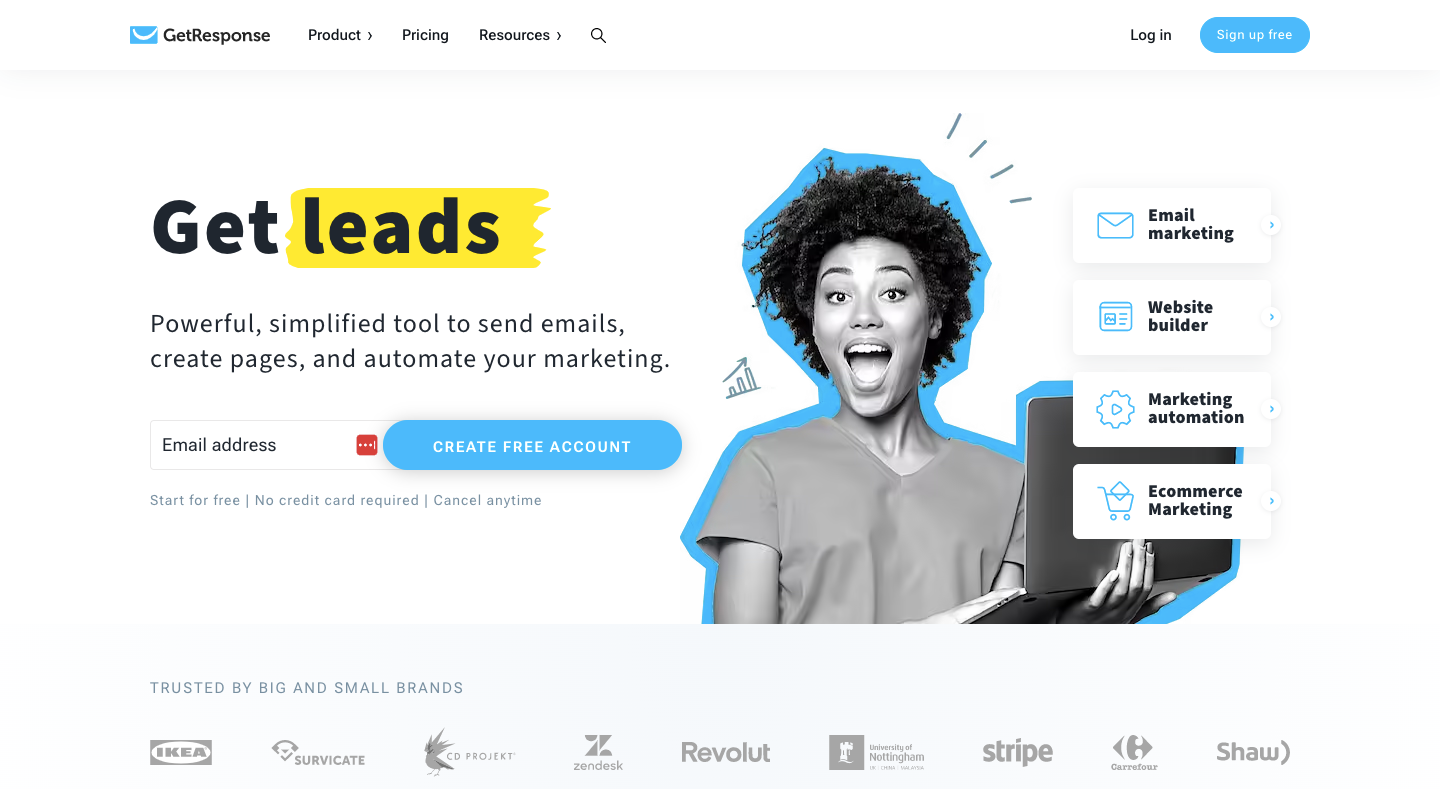 GetResponse is similar to Mailchimp: both are all-round marketing automation platforms catering to everyone from solopreneurs to enterprise-grade businesses. We’ve already looked at Mailchimp as a potential HubSpot alternative. But how does GetResponse stack up?
GetResponse is similar to Mailchimp: both are all-round marketing automation platforms catering to everyone from solopreneurs to enterprise-grade businesses. We’ve already looked at Mailchimp as a potential HubSpot alternative. But how does GetResponse stack up?
What Makes GetResponse the Best HubSpot Alternative?
- Send more emails, cheaper. Have we mentioned that HubSpot is pretty expensive? To (further) illustrate our point, GetResponse charges $13.30/month to send unlimited emails to up to 1,000 contacts. With HubSpot, 1,000 contacts will set you back $18/month—and you only get 5,000 monthly emails.
- Cheaper for larger list sizes. GetResponse isn’t just cheaper for sending high volumes of emails; it’s also better value for brands with large marketing lists. For instance, GetResponse charges $65/month for 10,000 contacts and unlimited emails on its entry-level Email Marketing plan. HubSpot’s equivalent package costs more than twice as much (and it doesn’t even include unlimited emails).
- Get email automation for less. GetResponse bundles all its automation functionality into its appropriately named Marketing Automation package, priced from $48/month. HubSpot includes up to 10 automated actions in its Starter plan, priced from just $18/month. But if you need more automations, you’ll have to take the huge leap up to HubSpot Marketing Professional ($800+ per month).
- Host webinars within the platform. Surprisingly for a B2B inbound marketing platform, HubSpot doesn’t offer built-in webinar hosting, so you’ll need to shell out extra for a third-party integration. GetResponse offers webinar hosting as standard at Marketing Automation level and above (priced from $48/month).
How Does GetResponse Compare to HubSpot?
| GetResponse | HubSpot | |
| Best Feature | Built-in GPT-3.5-powered email generator. | Connect marketing, sales, content management, and customer service in a single platform. |
| Best For | Small businesses that need advanced marketing tools | B2B inbound marketing |
| Pros | Cheaper prices for high email volumes and large marketing lists. | Offers way more functionality than just marketing; has a more generous free plan. |
| Cons | HubSpot’s free plan is better; GetResponse doesn’t do all the extra sales and customer service stuff. | Expensive if all you want is an email marketing and automation tool. |
| Pricing/Month | Free for up to 500 contacts and 2,500 monthly email sends. Paid plans start at $13.30 per month for 1,000 contacts and unlimited email sends. | Free marketing plan includes unlimited contacts and 2,000 monthly email sends. Paid marketing plans start at $18 per month for 1,000 contacts and 5,000 monthly sends. |
| Support | Paid plans include 24/7 support via chat and email. Phone support is only available at top-tier MAX2 level; some MAX2 customers can also access Slack support. | Paying customers can get 1:1 email and in-app chat support. Phone support is available at Pro level and above. |
5. Brevo (FKA Sendinblue)
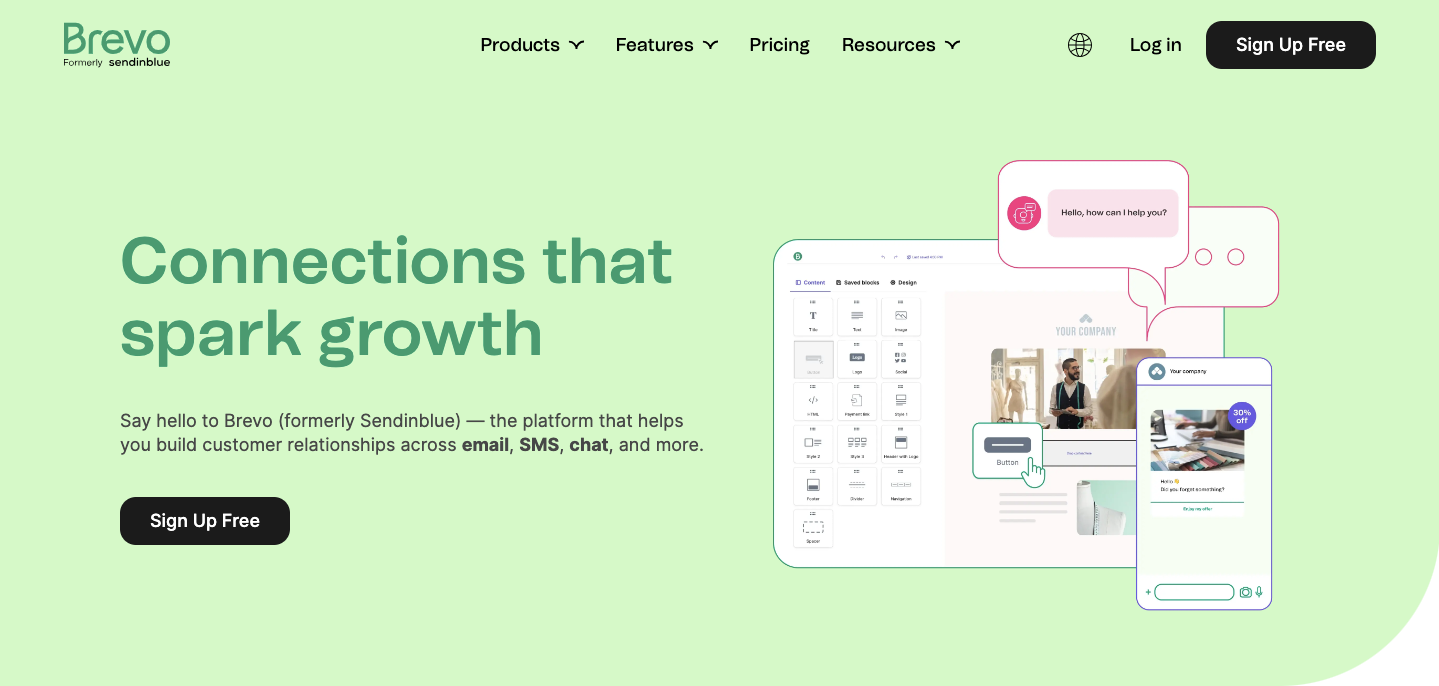 Brevo is a new(ish) name on the scene. But it’s not a particularly new tool, having launched back in 2012 under its previous guise, Sendinblue. Despite the rebranding, Brevo retains Sendinblue’s status as an affordable yet feature-packed marketing automation platform.
Brevo is a new(ish) name on the scene. But it’s not a particularly new tool, having launched back in 2012 under its previous guise, Sendinblue. Despite the rebranding, Brevo retains Sendinblue’s status as an affordable yet feature-packed marketing automation platform.
What Makes Brevo the Best HubSpot Alternative?
- More generous free plan. Brevo’s free product tier is arguably the most generous of any marketing automation tool, offering unlimited contacts and up to 300 emails a day (plus customizable email templates, and even SMS and WhatsApp campaigns). HubSpot’s free plan is still pretty generous, but it can’t match Brevo.
- Send transactional emails on all plans. Even if you only sign up for Brevo’s free plan, you can use your allowance to send transactional emails like order confirmations, shipping updates, and password resets. HubSpot offers transactional emails, too, but only at Marketing Professional level and above (which, as we’ve noted plenty of times already, costs from $800/month).
- Cheaper for large list sizes. All Brevo plans include unlimited contacts, making it a low-cost choice for brands with huge marketing lists. HubSpot’s prices rise sharply when you add more contacts—for instance, you pay an extra $18/month per 1,000 contacts on the Marketing Starter plan.
- Low-cost SMS marketing. Brevo lets you bolt-on SMS marketing to any plan on a pay-as-you-go basis (e.g. 1,000 US SMS messages cost just $10.90). HubSpot’s SMS functionality is only available as a beta at its Professional tier (and higher).
How Does Brevo Compare to HubSpot?
| Brevo | HubSpot | |
| Best Feature | Send transactional emails with guaranteed 97 percent deliverability. | Connect marketing, sales, content management, and customer service in a single platform. |
| Best For | Low-budget email marketing | B2B inbound marketing |
| Pros | More generous free plan; includes transactional emails on all plans. | High-quality (free) CRM. |
| Cons | HubSpot’s free CRM is better. | Attractive features like SMS marketing and transactional emails are only available to higher-tier customers. |
| Pricing/Month | Free for unlimited contacts and up to 300 emails per day. Paid plans start at $25 per month for unlimited contacts and 20,000 emails per month. | Free marketing plan includes unlimited contacts and 2,000 monthly email sends. Paid marketing plans start at $18 per month for 1,000 contacts and 5,000 monthly sends. |
| Support | The $25+ per month Starter plan only offers email-based support. To receive personalized support, you’ll need to subscribe to an Enterprise plan. | Paying customers can get 1:1 email and in-app chat support. Phone support is available at Pro level and above. |
6. Omnisend
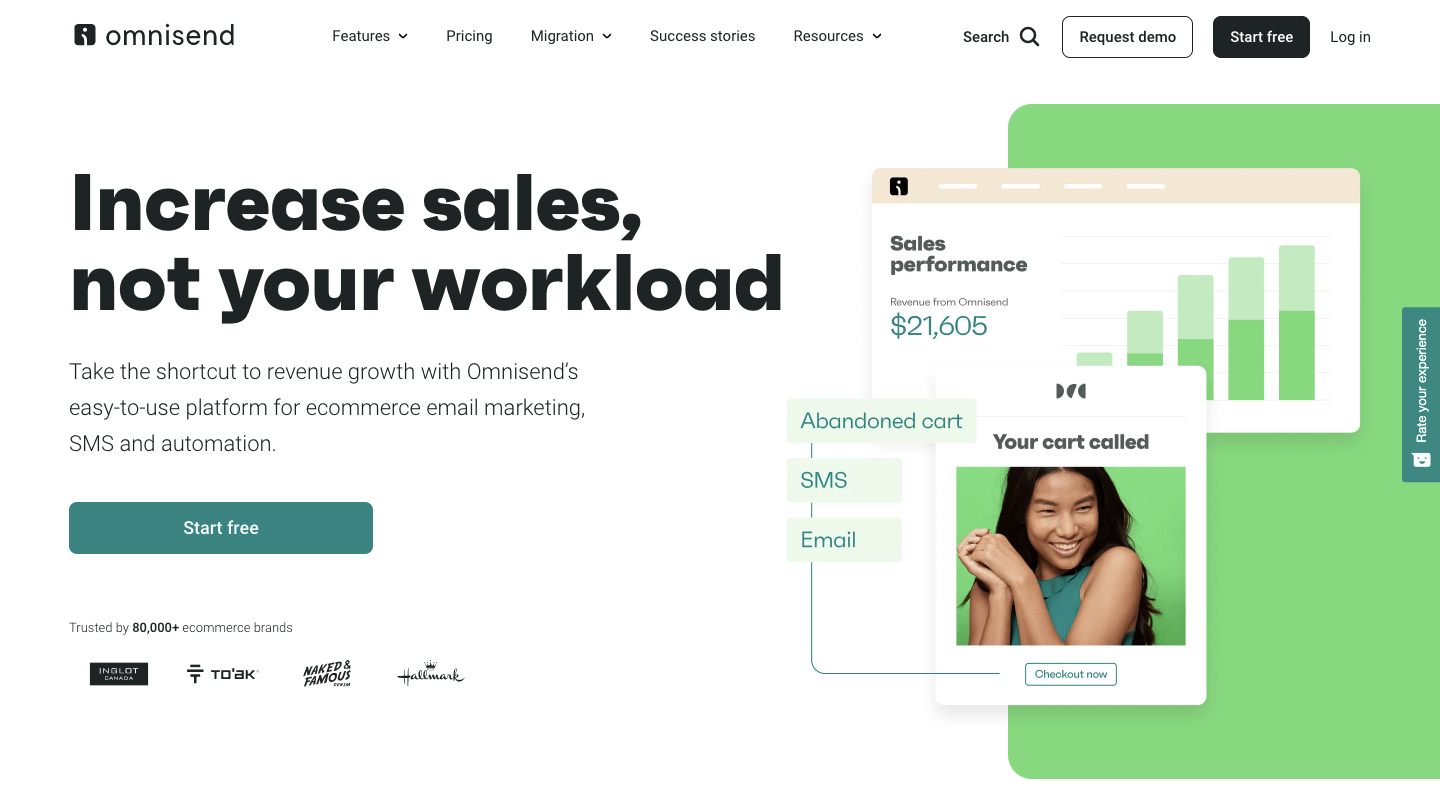 Omnisend is another ecommerce-centric marketing automation platform. It’s used by 100,000+ businesses to manage their email and SMS campaigns, with noteworthy customers including Inglot and Hallmark.
Omnisend is another ecommerce-centric marketing automation platform. It’s used by 100,000+ businesses to manage their email and SMS campaigns, with noteworthy customers including Inglot and Hallmark.
What Makes Omnisend the Best HubSpot Alternative?
- Affordable SMS & push notification campaigns. Even Omnisend’s free plan includes (limited) SMS and push notifications. By contrast, HubSpot doesn’t do push campaigns at all, and it only offers SMS marketing at Pro level and above.
- Advanced automation on all plans. Again, every Omnisend plan includes the platform’s full range of automations and pre-built workflows. Unless you pay for Marketing Hub Professional (at $800+ per month), HubSpot limits you to a maximum of 10 automations (or just one for users of its free plan).
- Cheaper for larger lists. Omnisend’s prices ramp up far more gently than HubSpot’s. For instance, Omnisend charges $40/month for 3,000 contacts and 36,000 monthly emails. HubSpot’s closest comparable plan costs $54/month and only includes 15,000 emails.
How Does Omnisend Compare to HubSpot?
| Omnisend | HubSpot | |
| Best Feature | Web push notifications allow brands to instantly retarget customers. | Connect marketing, sales, content management, and customer service in a single platform. |
| Best For | Ecommerce marketers | B2B inbound marketing |
| Pros | Lower prices and more functionality with all paid plans. | More generous free plan; free CRM; far wider-ranging feature set. |
| Cons | Can’t do all the sales, customer support, or social media management stuff that HubSpot offers. | Far more expensive as an email and SMS platform; doesn’t do push notifications. |
| Pricing/Month | Free to reach up to 250 contacts per month, including 500 monthly email sends, up to 60 SMS messages, and up to 500 web push notifications. Paid plans start at $16 per month to reach up to 500 contacts (including unlimited push notifications). | Free marketing plan includes unlimited contacts and 2,000 monthly email sends. Paid marketing plans start at $18 per month for 1,000 contacts and 5,000 monthly sends. |
| Support | All users get 24/7 email and live chat support, while Pro and Enterprise subscribers also get a dedicated customer success manager. | Paying customers can get 1:1 email and in-app chat support. Phone support is available at Pro level and above. |
7. ActiveCampaign
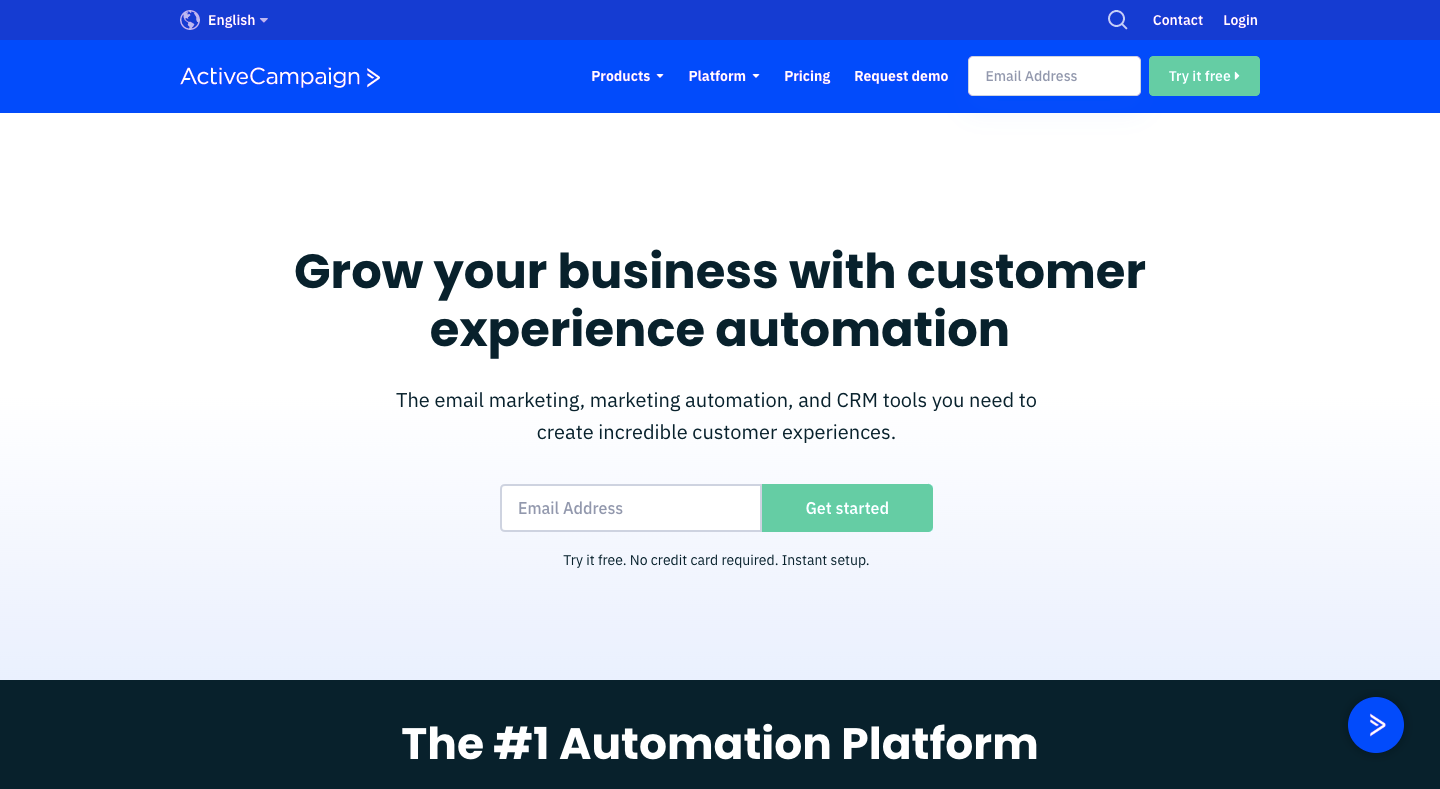 ActiveCampaign is one of the most sophisticated marketing automation platforms, and its wealth of sales, marketing, and ecommerce features appear to make it a natural HubSpot competitor. Just like HubSpot, it also gives customers the option to purchase its marketing automation and sales CRM products separately or as discounted bundles.
ActiveCampaign is one of the most sophisticated marketing automation platforms, and its wealth of sales, marketing, and ecommerce features appear to make it a natural HubSpot competitor. Just like HubSpot, it also gives customers the option to purchase its marketing automation and sales CRM products separately or as discounted bundles.
What Makes ActiveCampaign the Best HubSpot Alternative?
- Superior (standard) reporting. HubSpot offers a giddying array of reporting tools—multiple dashboards, customizable reports, and more—but all the fanciest stuff is locked away behind the platform’s reporting add-on, which costs $200/month. ActiveCampaign’s standard reporting tools are far superior, including automation reports, goal-based reports, contact trend metrics, and more.
- Boost open rates with predictive sending. ActiveCampaign’s AI-powered predictive sending feature (available at Professional level, priced from $149/month) sends emails when individual recipients are most likely to engage. Smart stuff! You’ll need a third-party integration to do that through HubSpot.
- Cheaper CRM and marketing bundles. ActiveCampaign is by no means a cheap platform. But if you want to bundle sales CRM and marketing automation, its prices are far more appealing than HubSpot’s. For instance, a Professional-level automation and CRM bundle including 2,500 contacts will set you back $385/month with ActiveCampaign, compared to $818/month with HubSpot.
- Low-cost transactional emails. With ActiveCampaign, you can bolt-on 10,000 transactional emails to any plan for just $15/month, whereas HubSpot only offers them at Professional level and above.
How Does ActiveCampaign Compare to HubSpot?
| ActiveCampaign | HubSpot | |
| Best Feature | Predictive actions use machine learning to deliver customer experiences based on data, such as the best time to send emails. | Connect marketing, sales, content management, and customer service in a single platform. |
| Best For | Advanced marketers who need high-level automation | B2B inbound marketing |
| Pros | Cheaper prices for similarly advanced features. | Has a generous free plan. |
| Cons | No free plan. | Once you upgrade from the free plan, HubSpot becomes far more expensive. |
| Pricing/Month | From $29 per month for one user and unlimited emails. | Free marketing plan includes unlimited contacts and 2,000 monthly email sends. Paid marketing plans start at $18 per month for 1,000 contacts and 5,000 monthly sends. |
| Support | All ActiveCampaign plans offer 24/7 email and chat-based support, but only Enterprise customers get over-the-phone support. | Paying customers can get 1:1 email and in-app chat support. Phone support is available at Pro level and above. |
8. AWeber
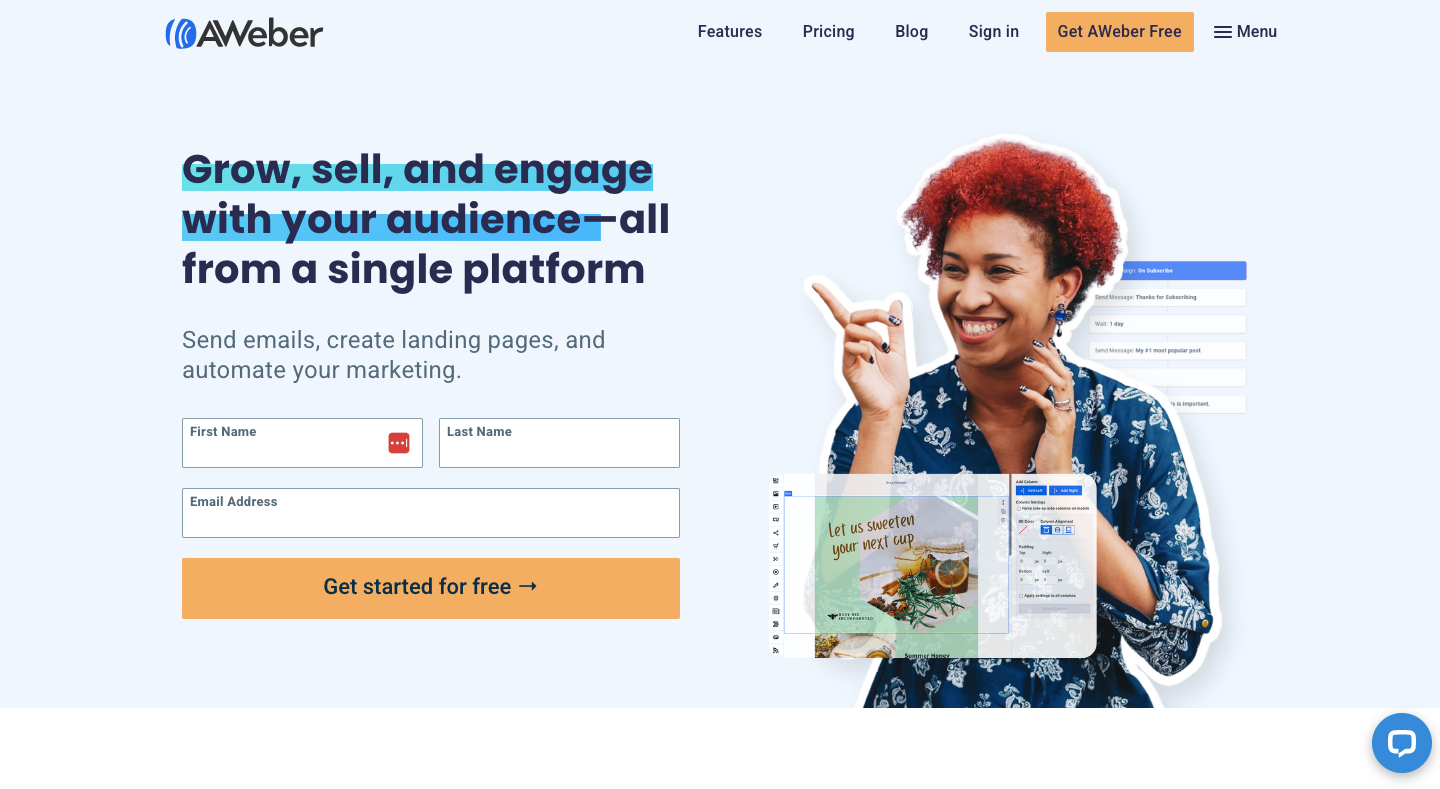 AWeber made its name as an affordable, user-friendly email marketing platform, but down the years it’s added a bunch of additional functionality to keep pace with more advanced tools like ActiveCampaign… and HubSpot.
AWeber made its name as an affordable, user-friendly email marketing platform, but down the years it’s added a bunch of additional functionality to keep pace with more advanced tools like ActiveCampaign… and HubSpot.
What Makes AWeber the Best HubSpot Alternative?
- Send web push notifications. Unless you use a third-party integration, you can’t run push notification campaigns through HubSpot. AWeber, on the other hand, offers web push notifications on all plans, including its free tier.
- Phone-based technical support. Got a problem? AWeber lets you pick up the phone and speak to a real human, even if you’re only using its free plan. With HubSpot, you only get phone-based support at Professional level and above (priced from $800/month).
- Build customized email templates, fast. With AWeber, you can paste your website or Facebook page URL into its smart designer to automatically generate email templates tailored to your brand. HubSpot doesn’t offer anything like this, although it does have a (small) library of free templates.
- Cheaper for high email volumes. All paid AWeber plans include unlimited emails, making it an affordable choice for brands sending high volumes of emails. HubSpot doesn’t offer unlimited emails on any plan.
How Does AWeber Compare to HubSpot?
| AWeber | HubSpot | |
| Best Feature | Create email templates in seconds using your website or Facebook page URL. | Connect marketing, sales, content management, and customer service in a single platform. |
| Best For | Startups and small businesses | B2B inbound marketing |
| Pros | Much cheaper for sending high email volumes. | More generous free plan; free CRM. |
| Cons | Less advanced CRM; far more limited feature set. | Paid plans are much more expensive if you only need to send emails. |
| Pricing/Month | Free for up to 500 email subscribers and 3,000 monthly email sends; paid plans priced from $12.50 per month for up to 500 subscribers and unlimited emails. | Free marketing plan includes unlimited contacts and 2,000 monthly email sends. Paid marketing plans start at $18 per month for 1,000 contacts and 5,000 monthly sends. |
| Support | All users—even free subscribers—can access 24/7 live support via phone, email, and chat (although paying customers are placed in a priority queue). | Paying customers can get 1:1 email and in-app chat support. Phone support is available at Pro level and above. |
9. Constant Contact
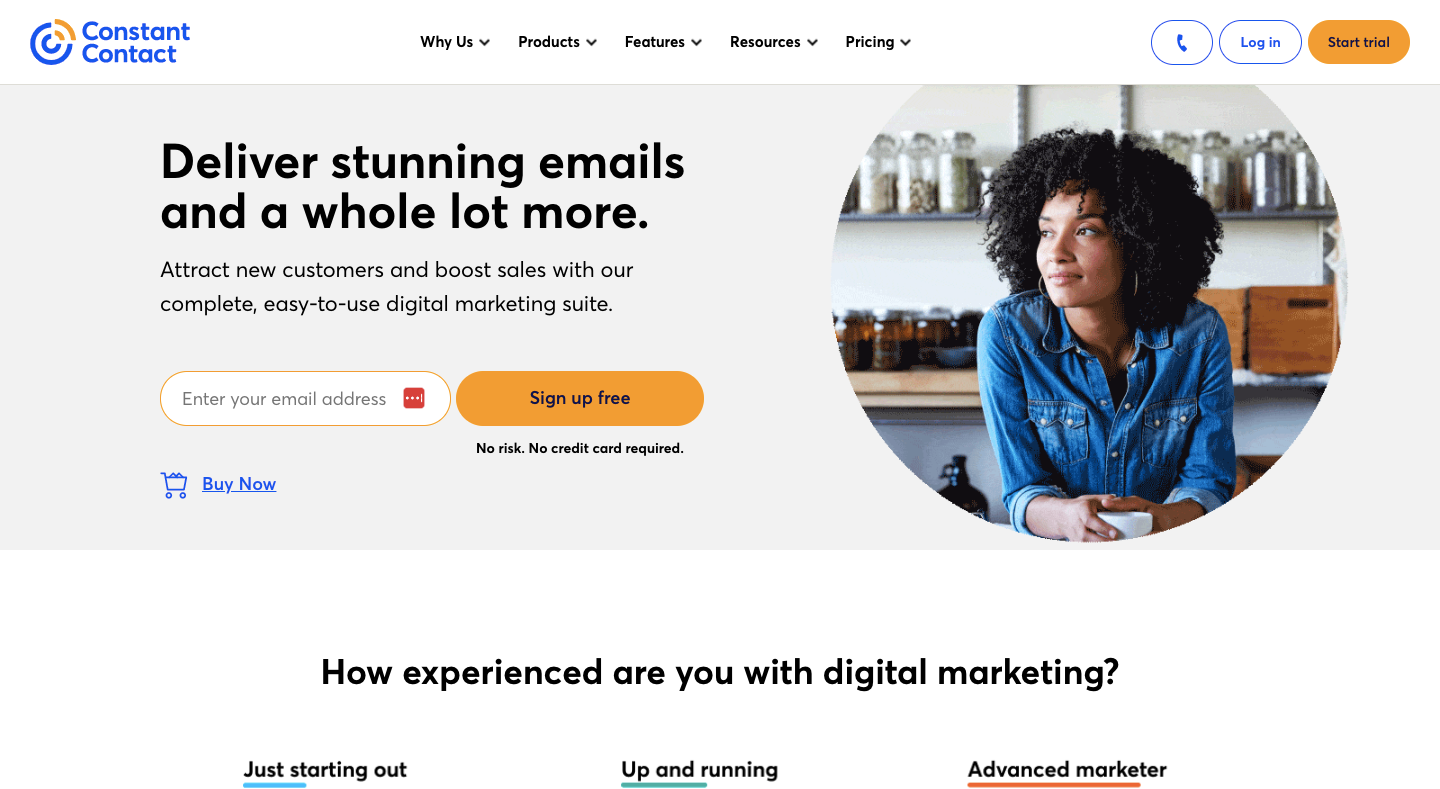
Constant Contact is another old school email marketing platform that’s added a ton of fancy new features in recent years. It targets startups, small businesses, and advanced marketers—a similar audience to HubSpot’s lower-tier plans.
What Makes Constant Contact the Best HubSpot Alternative?
- Low-cost social scheduling. Constant Contact’s mid- and top-tier packages offer built-in social media scheduling, while all plans include social media posting. Of course, HubSpot does both of these things, too—but only at Marketing Hub Professional level and above, priced from $800/month.
- Built-in event marketing. Given HubSpot’s strong B2B slant, you’d imagine event marketing would be a core part of its proposition. However, you can’t sell event tickets through HubSpot without an integration, whereas Constant Contact offers built-in event marketing tools on all price plans.
- Phone-based support. All Constant Contact can access phone-based customer service—a privilege HubSpot reserves for subscribers at Marketing Hub Professional level and higher.
How Does Constant Contact Compare to HubSpot?
| Constant Contact | HubSpot | |
| Best Feature | Manage campaigns on the go from a dedicated mobile app. | Connect marketing, sales, content management, and customer service in a single platform. |
| Best For | Nonprofits and charities (they save up to 30 percent on standard Constant Contact prices) | B2B inbound marketing |
| Pros | Built-in social media and event management tools with all plans. | Excellent free plan and a more expansive feature set. |
| Cons | Expensive prices for a comparatively limited feature set; no free plan. | Social media management only available to higher-tier customers. |
| Pricing/Month | From $12 per month for up to 500 contacts and 5,000 monthly email sends. | Free marketing plan includes unlimited contacts and 2,000 monthly email sends. Paid marketing plans start at $18 per month for 1,000 contacts and 5,000 monthly sends. |
| Support | All plans offer live chat and phone support, while Standard and Premium customers get onboarding calls too. | Paying customers can get 1:1 email and in-app chat support. Phone support is available at Pro level and above. |
10. ConvertKit
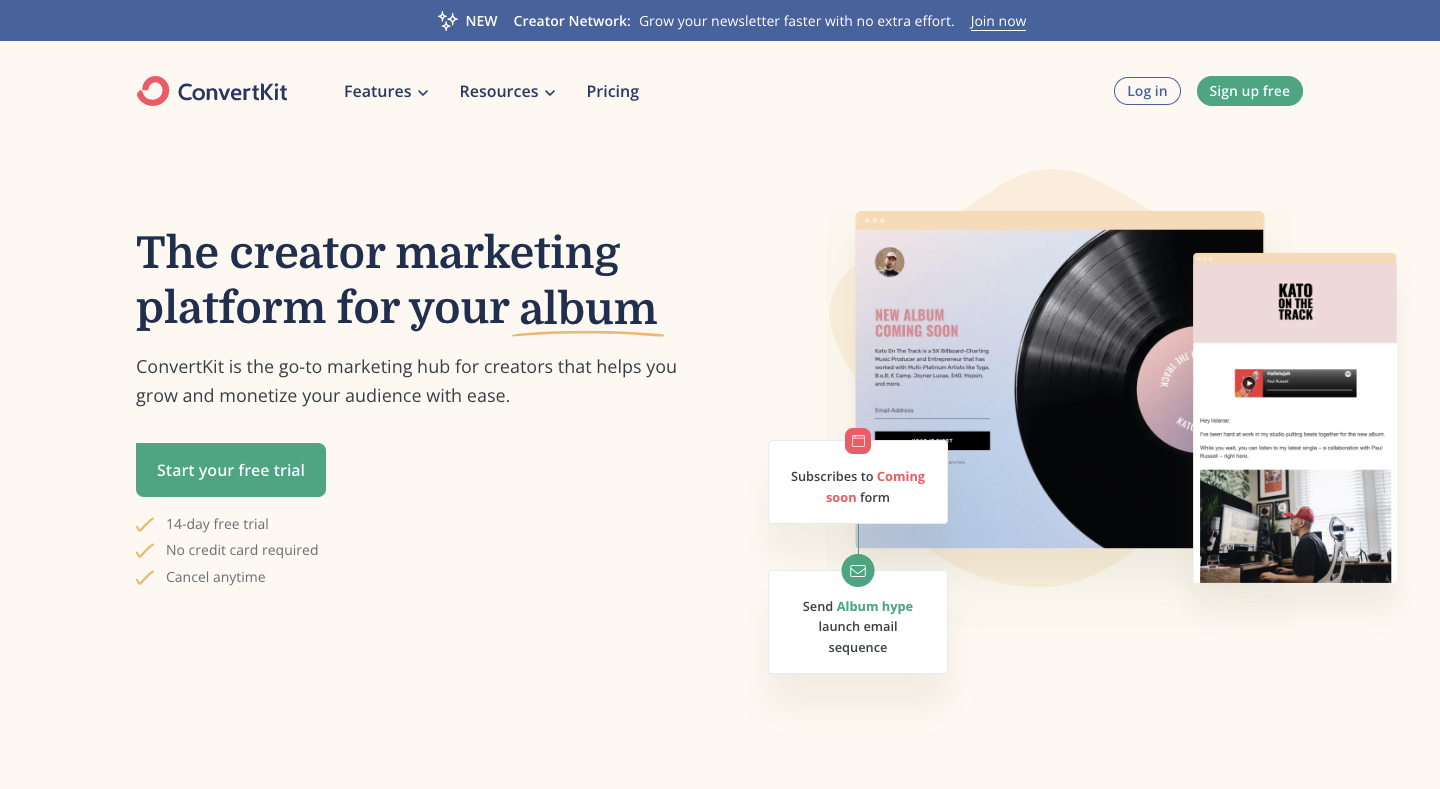 Frankly, ConvertKit and HubSpot have next to nothing in common, beyond the fact you can use both platforms to send emails. ConvertKit is designed for individual content creators—authors, coaches, musicians, podcasters, and more—whereas HubSpot targets small, medium, and enterprise-level businesses. Still, we’ll do our best to compare them!
Frankly, ConvertKit and HubSpot have next to nothing in common, beyond the fact you can use both platforms to send emails. ConvertKit is designed for individual content creators—authors, coaches, musicians, podcasters, and more—whereas HubSpot targets small, medium, and enterprise-level businesses. Still, we’ll do our best to compare them!
What Makes ConvertKit the Best HubSpot Alternative?
- Fantastic free plan. If we could only pick one free email marketing tool, we’d choose Brevo. But ConvertKit is a close second, offering 1,000 contacts and unlimited emails, landing pages, and forms—plus basic tagging and segmentation. HubSpot’s free tier certainly isn’t bad, but it can’t compete here.
- Get recommendations from fellow creators. When you join the Creator Network (available on all paid plans), you gain the ability to recommend—and be recommended by—other content creators, helping you grow your audience. HubSpot wasn’t built for creators and doesn’t offer anything similar.
- Built-in email monetization. If you’ve got 10,000+ email subscribers, ConvertKit will actively seek out paid sponsorships for your newsletters, giving you a new avenue to monetize your content. Again, HubSpot doesn’t do this.
- Inclusive referral marketing. ConvertKit’s top-tier Creator Pro plan, priced from $25/month, includes free access to SparkLoop’s referral marketing platform—giving creators yet another way to reach new audiences. HubSpot has a SparkLoop integration, but you’ll have to pay for it.
How Does ConvertKit Compare to HubSpot?
| ConvertKit | HubSpot | |
| Best Feature | Integrated newsletter referral program helps creators grow their reach by leveraging their existing audience. | Connect marketing, sales, content management, and customer service in a single platform. |
| Best For | Content creators | B2B inbound marketing |
| Pros | Built-in monetization and audience growth tools for creators. | Far more advanced reporting, segmentation, and automation; free CRM. |
| Cons | Only offers a fraction of HubSpot’s functionality. | Pretty expensive, especially if you’re just looking for an email tool. |
| Pricing/Month | Free for up to 1,000 subscribers and unlimited email sends; paid plans start at $9 per month for up to 300 subscribers and unlimited sends. | Free marketing plan includes unlimited contacts and 2,000 monthly email sends. Paid marketing plans start at $18 per month for 1,000 contacts and 5,000 monthly sends. |
| Support | Paying customers get live chat and email support, with priority access offered to Creator Pro subscribers. Free subscribers only get community support. | Paying customers can get 1:1 email and in-app chat support. Phone support is available at Pro level and above. |
Frequently Asked Questions
Yes, there are! Few tools can compete with HubSpot’s vast feature set. But if you’re just looking for an email and marketing automation platform, every tool in this roundup does the job just as well as HubSpot—and often at a fraction of the price.
No! Google doesn’t do email marketing, sales CRMs, or marketing automation. However, you can transform Gmail into a basic email marketing tool using a third-party plugin, and Google Workspace integrates with various CRM platforms.
Probably not. If email marketing is your goal, HubSpot’s free plan is a decent option, offering unlimited contacts and up to 2,000 emails per month. But once you outgrow the free functionality—and you will—you’ll find plenty of cheaper (and better) email and automation tools.
HubSpot’s biggest problem comes when you want to upgrade beyond its solid free plan. Its cheapest paid plan—Marketing Hub Starter—is pretty limited (for instance, it only offers up to 10 automations and basic reporting). You only get vital features like transactional emails, unlimited automations, and advanced reporting at Marketing Hub Professional level and above, which costs $800+ per month and only includes 2,000 contacts. That’s eye-wateringly expensive compared to any other email software.

Conclusion
We could sum up this whole guide to HubSpot alternatives by saying:
HubSpot is amazing, but if you’re “just” looking for marketing automation, every other platform is cheaper.
To give you just one comparison, Drip gives you advanced automations, onsite campaigns, laser-targeted segmentation, unlimited emails, and up to 2,500 contacts for $39/month. HubSpot’s most comparable plan costs 20 times more (plus you only get 2,000 contacts and 20,000 emails).
Ridiculous, right?
So if you’re too big for HubSpot’s free plan, we highly recommend taking Drip for a test-drive. Sign up for your 14-day free trial today!
